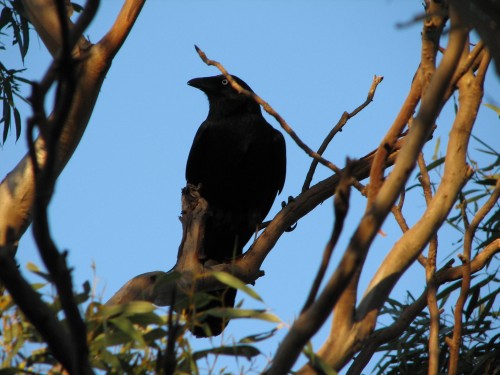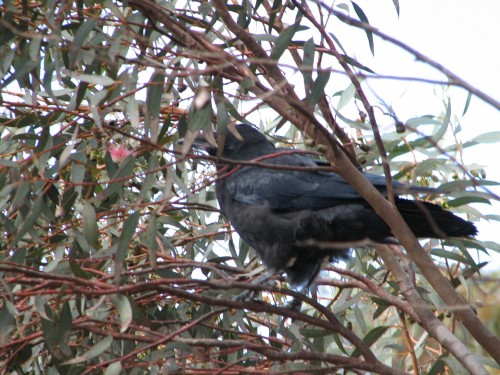Annoyingly noisy ravens around our house
Over the last few weeks, I have been intrigued, puzzled and just a little annoyed.
Intrigued
I have been intrigued by all of the Little Ravens in our garden, on our five-acre property and along the nearby roadsides. While we only ever have two to five ravens at a time on our block of land, there would have to be at least 50 to 80 in the locality, perhaps more than that within a kilometre of our house. Obviously, there is plenty of food for them, as well as plenty of nesting sites. There is quite an extensive mallee scrub a few hundred metres just to the west of us.
Puzzled
I am puzzled because I am not sure what they are up to at present. Almost every morning this year I have heard large numbers of the local ravens constantly calling. It is usually from just after first light at around 6:30 am up until around 9 am and sometimes a little later. After that, there is just the occasional call as one or two fly overhead, or when they land in one of our trees. I have no idea why they are all calling, or why it stops after a while.
Annoyed
I have also been annoyed with the local Little Ravens, not only because I am puzzled by this behaviour, but it can get a little tedious after an hour or so of this calling, calling, calling. Normally, bird calls do not easily annoy me, though I will concede that if we had 500 Little Corellas wake us up every morning I would definitely change my mind. Thankfully that does not happen, though the local flocks of Galahs can sometimes be rather raucous, though they tend to fly overhead at sunset rather than at dawn.
Dilemma
I, therefore, have something of a dilemma. What are they doing? Why are they calling so incessantly?
I guess I will never know – unless I do an intensive field survey over many weeks in the field when I’d rather be in bed, or reading the paper.
I guess I could always try to learn how to speak Raven.
Good birding,
Trevor
Further reading:
Bird Word: Corvids
- Corvids: birds that belong to the crow or raven family of birds
Crows and ravens, members of the corvid family of birds, are a common species in much of the world. In fact, this family of birds is found throughout the world except the polar caps and the very tip of South America. According to the Wikipedia article this family also includes rook, jackdaws, jays, magpies, treepies and nutcrackers. It claims that there are over 120 different species of corvids in total.
In Australia the members of this family include:
- Australian Raven
- Little Raven
- Little Crow
- Forest Raven
- Torresian Crow
Related Articles:
- Thieving birds – our resident ravens are caught stealing something very unusual.
- Ravens v Choughs – fights between the White Winged Choughs and the Little Ravens in our garden.
- Clever Crows – the may be cunning, they may be annoying, but they really are clever.
- Something to crow about – more about clever crows
- Glossary of bird words – more words about birds explained.
Thieving Birds
A few days ago we had just pulled out of the driveway on our way to Adelaide when I realised that the windscreen was rather dirty. I activated the wipers and the resultant screeching brought me to a quick halt. My wife alighted and she discovered that the left hand wiper blade was missing!
On my return home I went to the spot where the car had been parked. Sure enough, there on the ground was the missing blade. The Little Ravens had been fussing around on the mirror adjacent the wiper for several days. They are my chief suspects at this point, but I have no conclusive evidence.
Over recent months I have observed the following species fussing around the cars, and the mirror in particular: Little Ravens, Australian Magpies, Grey Shrike-Thrush, Willie Wagtail, Magpie Lark and Red Wattlebird. All are suspects, but my money would be on the ravens.
How the bird in question got the rubber wiper blade out beats me. It was hard enough getting it on in the first place. (I replaced both blades a few months ago.)
And why didn’t the bird in question at least have the decency to use the blade in its nest?
UPDATE:
I posted this article this morning. I hadn’t used said vehicle for several days. Guess what? The blighters have done it again! Same wiper blade completely removed and left on the ground. The other wiper blade was part way out!
Related Articles:
Why do baby birds disappear?
One of my regular readers recently asked the question: “Why do baby birds disappear?” We had been corresponding during the recent height of the Australian breeding season. Spring here is coming to a close, but many birds are still actively making nests, sitting on eggs or feeding young in the nest or just out of the nest. This reader observed that many baby birds go missing. What happens to them, she asked.
Here is my reply:
It is very distressing for bird lovers to see the little birds disappear or be killed in some way so soon after hatching or leaving the nest. If we knew the figures, I think we would be horrified by the enormous attrition rate in our fauna, not just birds.
Some possibilities include the following:
1. Removal from the nest by cuckoos. We have several species of cuckoos in Australia. The female lays one egg in a host nest. This could be a thornbill, honeyeater or a range of other species. The host bird hatches the eggs and the baby cuckoo hatches first and it removes all other eggs in the nest in the first hour or so after hatching. It then gets ALL the food from the host parents. Harsh yes – but this is normal, natural cuckoo behaviour.
2. Predation of eggs or chicks: this could be from ravens, crows, currawongs, butcherbirds, hawks and even magpies. Cats, foxes, snakes and lizards, especially goannas, will also raid nests.
3. Predation out of the nest: Once fledged and out of the nest the young birds run the gauntlet of so many hazards including all in number 2 above. Add to those hazards the problem of being hit by speeding cars, wild storms, flying into glass panes (very common), captured by well meaning people and not cared for properly, heavy rain, cold nights and so on.It is a wonder that any survive at all, especially in urban areas. This is in part compensated for by the following strategies:
(a) Laying 3-5 eggs for each clutch as this increases the success rate
(b) cleverly camouflaging the nest – with all my experience I am still fooled by their cryptic nest sites.
(c) breeding two or three times in one season.It would certainly help if all cat owners were responsible and made a run for their animals. This would eliminate some deaths in our fauna, but a far greater problem is the feral cats. There is no control of these and all are very big, strong and cunning. I think compulsory desexing of cats is the way to go, but it would only be a start. Catching all the feral cats is probably not feasible. Making sure no more are added to their ranks will be a good start though.
Related articles:
- Common Blackbirds – the article that started it all. The many comments are very interesting reading.
- Do Blackbirds Swoop? How to deal with aggressive bird behaviour – another article I wrote about Blackbirds. This one also created a great deal of interest with many interesting comments.
- Magpies behaving badly – Australian Magpies have a bad reputation during breeding season.
- A bit on the nose – an amusing incident involving a cyclist, a swooping Red Wattlebird and a nose.
- Anyone for a swim? Forget it baby Blackbird. Now this is something different.



